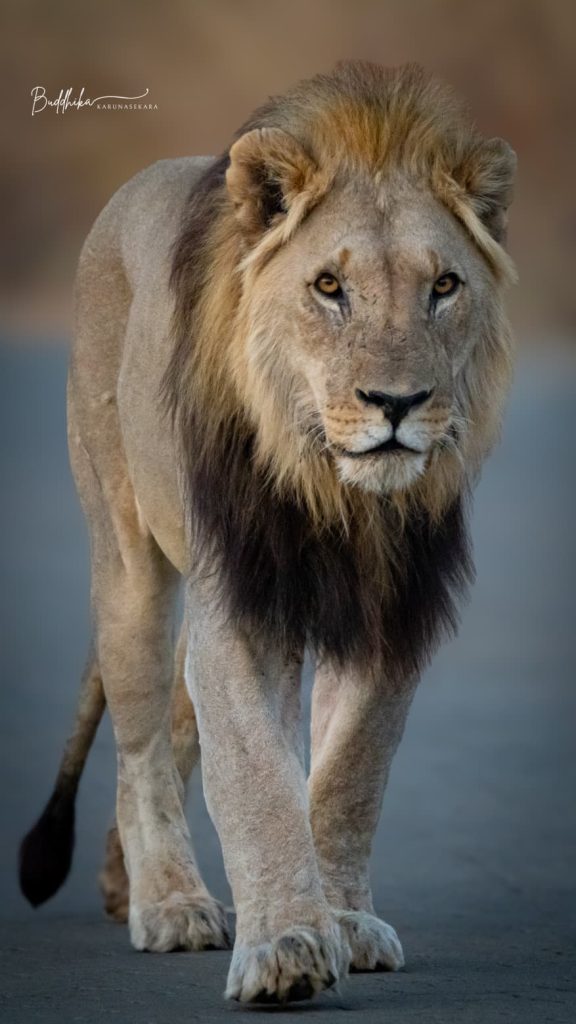
Majestic and commanding, the lion is perhaps the most storied creature of the African plains. Known as the “king of beasts”, it has long captured human imagination with its golden mane, thunderous roar, and proud bearing. Unlike the solitary leopard or cheetah, lions live in prides, their social structure giving them strength in numbers and making them formidable hunters. Their presence has marked landscapes from the African savannah to the edges of India, where the Asiatic lion still lingers in the Gir Forest.
In African traditions, the lion often embodies courage, authority, and danger. Among the Akan people of Ghana, the lion is a symbol of power, its name invoked in proverbs to describe leaders and warriors. The Zulu of South Africa recount stories in which the lion is a creature both feared and revered, representing the untamed spirit of the wild. In Swahili folktales along the East African coast, the lion often appears as a judge or ruler, settling disputes among animals and reminding listeners of the value of justice balanced with strength.
Beyond Africa, the lion’s image travelled with merchants, missionaries, and storytellers. In the Middle East, the lion was associated with both kingship and divine protection. Persian epics celebrate lions as symbols of heroism, and in Islamic tradition the lion became linked with Ali, the cousin of the Prophet Muhammad, who was called “Lion of God”. In India, the lion is entwined with religious and cultural lore, appearing as the mount of the goddess Durga and as the form taken by Vishnu in his Narasimha incarnation, half man and half lion, to protect the world from tyranny. Such stories reveal how the lion has stood as a guardian figure across diverse belief systems.
In Sri Lanka, the lion holds an even deeper place in national mythology. The very name of the Sinhalese people derives from the word Sinhala, meaning “of the lion”. According to the ancient chronicle Mahavamsa, the island’s first king, Vijaya, was said to be descended from a lion through the union of the lion Sinhabahu and a princess. This tale of ancestry gave the lion a central place in identity, tying the people to a lineage of courage and dominion. The lion also appears in art and architecture, carved in stone at temple entrances and painted on banners, serving as a guardian figure. Today, the lion remains the emblem of Sri Lanka’s national flag, carrying forward this legendary connection between people, land, and beast.
European folklore added further layers of meaning. Medieval bestiaries described the lion as noble and Christ-like, believed to sleep with its eyes open and to revive its cubs with a roar on the third day after birth. Such imagery blended natural observation with spiritual allegory, turning the lion into an emblem of both majesty and salvation. Heraldry across Europe carried lions on shields and banners, the creature embodying bravery, honour, and royal dignity.
Yet folklore also reminds us of the lion’s complexity. In some tales from East Africa, the lion is not only noble but also a trickster, outwitted by smaller animals like the hare or the tortoise. These stories offer lessons about humility, showing that even the mightiest can be overcome by wit and patience. Similarly, in Ethiopian oral traditions, the lion can symbolise both oppression and resistance, standing in for rulers who dominate, or for spirits of the land that protect communities.
Modern conservation stories echo these ancient values. Among Maasai communities in Kenya and Tanzania, the lion has long been part of warrior culture, with young men once proving their bravery through hunts. Today, these traditions are being reshaped, with lion guardianship replacing lion killing as a measure of courage. Elders and conservation groups work together to ensure that lions remain part of the living landscape, their presence tied to cultural pride as well as ecological balance.
The lion’s fate, like that of many great animals, now rests on the choices of humans. Across Africa, habitat loss and conflict with pastoralists threaten its survival. In India, the Asiatic lion has rebounded through protection in Gujarat, yet remains vulnerable. Folklore continues to play a role, as stories of lions are retold not only as legends of the past but as reminders of responsibility in the present.
To watch a lion stride across the plains is to witness a creature of story and spirit. Its roar carries the memory of ancient fireside tales, its presence woven into the heritage of many peoples. The lion is not only a predator but a keeper of meaning, a reminder that myth and life often share the same ground.
